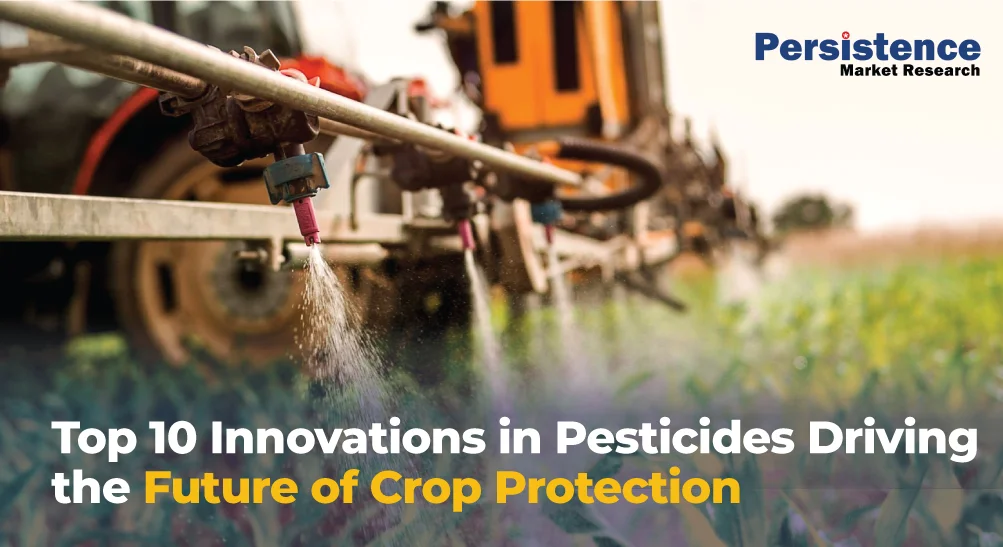- Blog
- Pesticides Market Trends
Top 10 Innovations in Pesticides Driving the Future of Crop Protection
Published On : 3 Sep 2025
The pesticide industry is undergoing a major transformation. Once dominated by synthetic chemicals, the sector is now embracing biological solutions, digital platforms, and precision technologies to address rising food demand, sustainability goals, and stricter regulations. For agribusiness leaders, investors, and policymakers, staying ahead of these innovations is essential to understanding growth opportunities and future market shifts.

Here are the top ten pesticide innovations that are reshaping modern agriculture and redefining the global crop protection market.
1. RNAi Based Pesticides
RNA interference (RNAi) technology allows scientists to silence essential genes in targeted pests, offering species-specific protection without harming beneficial organisms. These pesticides are biodegradable and highly precise, making them ideal for sustainable farming. Stability and delivery have historically been barriers, but advancements in formulation are now pushing RNAi pesticides closer to mainstream adoption.
2. Microbial and Biological Pesticides
Biological control agents such as bacteria, fungi, viruses, and beneficial nematodes are moving beyond niche applications. With regulators encouraging low-residue products and farmers seeking sustainable solutions, biopesticides are gaining ground in both organic and conventional agriculture. They are especially valuable in integrated pest management (IPM) systems where they can complement traditional formulas.
3. Nano Formulations and Advanced Delivery Systems
Nanoencapsulation and controlled release formulations are revolutionizing pesticide efficiency. These technologies improve stability, enhance uptake, and reduce chemical drift, leading to better pest control with smaller quantities of active ingredients. Nanoformulations are particularly valuable for fragile biologicals and RNAi-based products, helping them survive environmental challenges and perform effectively in the field.
4. Drone Application Systems
The use of drones in agriculture has expanded rapidly. Drones equipped with advanced spraying systems allow targeted application, reduce chemical waste, and minimize operator exposure. For high-value crops and fragmented farmland, drones provide cost-effective solutions and enable farmers to react quickly to pest outbreaks. The rise of drone-as-a-service models is also creating new business opportunities in the pesticide sector.
5. Smart Sprayers and AI Spot Spraying
Artificial intelligence and computer vision are bringing precision to ground and aerial spraying. Smart sprayers equipped with sensors and cameras can identify weeds or diseased plants in real time, applying pesticides only where needed. This reduces chemical usage, lowers environmental impact, and generates higher returns on investment for farmers managing large-scale operations.
6. Semiochemicals and Pheromone-Based Control
Pheromone dispensers and lure-and-kill systems are gaining popularity, especially in orchards and specialty crops. These products disrupt pest mating cycles and significantly reduce reliance on synthetic chemicals. Export-driven markets, which require low or zero pesticide residues, are particularly driving the adoption of pheromone-based pest control.
7. Gene Editing and Sterile Insect Techniques
Gene-editing tools such as CRISPR are advancing sterile insect technique (SIT) programs, which release sterile pests to naturally reduce populations. This approach minimizes chemical use and has long-term ecological benefits. While commercialization faces regulatory and social acceptance hurdles, pilot programs in controlled regions are showing promise for future market expansion.
8. Digital Pest Forecasting and Decision Support
Digital agriculture platforms are transforming pest management decisions. By combining weather data, satellite imagery, and pest population models, farmers can predict outbreaks and spray at the optimal time. These decision support tools reduce unnecessary pesticide use, improve yields, and open new revenue streams through subscription-based platforms.
9. Resistance Management and Synergistic Chemistries
Resistance to pesticides is a major global challenge. New molecules with novel modes of action and synergistic additives are being developed to enhance effectiveness while slowing resistance development. Stewardship programs, backed by strict resistance management guidelines, are ensuring the long-term sustainability of these innovations.
10. Safer Packaging and Application Systems
Closed transfer systems, precision nozzles, and micro-encapsulation technologies are making pesticide application safer for workers and more compliant with residue regulations. Improved packaging and delivery systems also enhance the adoption of biologicals, which often require more controlled conditions to remain effective.
Market Implications
The adoption of these innovations will not be uniform across all crops and regions. High-value crops such as fruits, vegetables, and export-oriented commodities will lead adoption of biopesticides, pheromones, and precision application technologies. Broad-acre crops will gradually integrate digital forecasting, drones, and resistance-aware chemistries as costs come down.
RNAi pesticides, nanoformulations, and microbial solutions represent the largest commercial opportunities in the coming decade. Their success, however, depends on regulatory approvals, cost efficiency, and strong partnerships between agri-input companies, technology providers, and research institutions.
Conclusion
The global pesticide industry is no longer confined to traditional chemistry. It is evolving into a multi-layered ecosystem that combines biology, data-driven precision, and advanced formulations. These innovations are not only reducing environmental impact but also creating new market segments and revenue streams.
For businesses and investors, tracking regulatory changes, adoption rates, and emerging partnerships will be key to identifying growth opportunities. The future of pesticides lies in smart, sustainable, and science-driven solutions that will redefine the way agriculture manages crop protection.
Industry Report

Request Report Sample
Your privacy is important to us; your data is secure
Contact Us
Latest Reports
-
Piezoresistive Pressure Sensor Market by Sensor Type (Absolute, Gauge, Differential, Sealed), Pressure Range (Low Pressure (<10 kPa), Medium Pressure (10 kPa – 1000 kPa), High Pressure (>1000 kPa)), End-Use Industry (Automotive & Transportation, Industrial Manufacturing, Healthcare, Aerospace & Defense, Electronics) and Regional Analysis for 2026-2033
-
Aquarium Accessories Market by Product Type (Filtration Items, Lights & Hoods, Temperature Control Systems, Others), End-User (Residential, Commercial), Distribution Channel (Online, Offline), and Regional Analysis for 2026-2033
-
Oxygen Therapy Market by Product Type (Compressed Oxygen, Concentrated Oxygen, Liquid Oxygen), Disease (Respiratory Disorder, Cardiovascular Disease, Sleep Apnea, Pneumonia), End-User (Hospitals, Home Healthcare, Clinics), and Regional Analysis for 2026-2033
-
Air Curtains Market by Product Type (Non‑Recirculating, Recirculating, Heated, Others), Airflow Capacity (Up to 500 m³/h, 500–1000 m³/h, 1000–1500 m³/h, Above 1500 m³/h), Application (Commercial, Industrial, Residential, Others), and Regional Analysis for 2026–2033
-
Personalized Stationery Market by Product type (Storage & Filling Products, Paper-Based Products, Drawing & Writing Instruments, Accessories, Bags, Others), Application (Educational Institutes, Corporate Offices, Personal Use, Hospitals, Others), and Regional Analysis for 2026–2033
